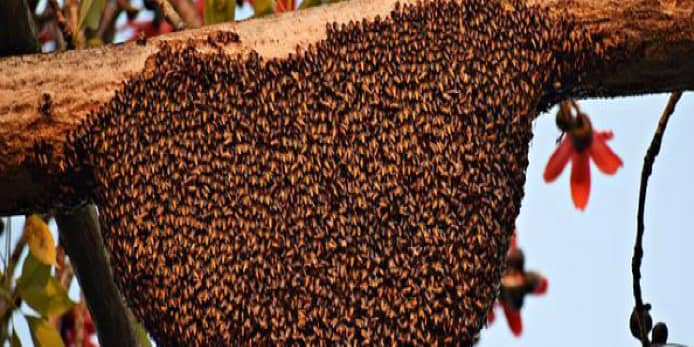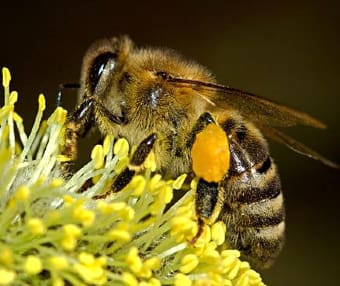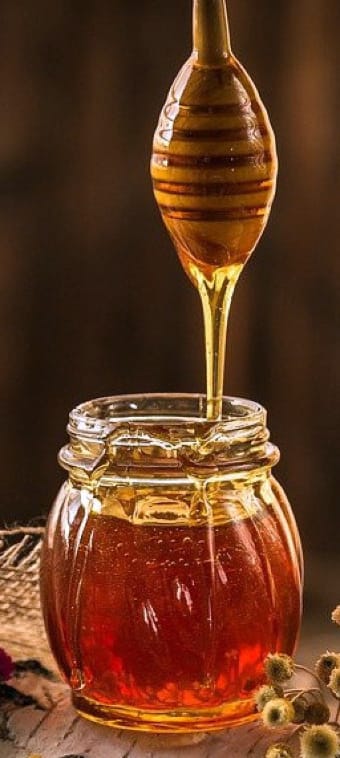What Does The Real Bee’s Knees Mean?

The Real Bee’s Knees: The Highest Standard For Comparison!
Our beloved bees travel 5 miles per day!
Did you know those tiny bees, are designed aerodynamically to be unable to fly?
So what does the real bee’s knees mean?
It’s the real deal, the highest standard with which something can be compared.
Bees are a wonder of nature.
The bees live for only 3 months, and travel five miles per day; that means they travel 450 miles in their lifetime. These are tiny little bees we are talking about here!
What Does The Real Bee’s Knees Mean?

nectar and resin.
A hive of 60,000 bees flies the equivalent distance from the earth to the moon, every day.
The worker bee flies at a top speed of 15 to 20 m/p/h when she’s flying toward the food. We hear the bzzz sound and can’t see the bee.
When she flies back to the hive, she slows down to 12 miles per hour, because she’s packing her own body weight in pollen, nectar, and resin.
To be honest – 12 mph is usually my start speed…
Do we own the bees? I think not. Would you like a bee as a pet? May-be.
Would you watch bees like watching an aquarium?… Yes, I think I would.
Would You Like To Own A Beehive?
Yes, I would love to own a beehive! This same honeybee that lives for 2 to 3 months, produces ONE teaspoon of honey in its lifetime.

Please don’t shoo them away or spray your flowers with insecticides. Think of the bee… after a long hard day of gathering pollen, he could go home to an empty hive.
My friend moved to an acreage and inherited a beehive. The seller showed her how to gather the honey and care for the bees.
It was the most magical moment in the world when that honey spilled off that honeycomb! Nature’s wonder.
Honey is a pure food and cannot rot or go bad. The tomb of Tutankhamun had jars of honey stacked in the crypt, to comfort him on his journey to another life.
That honey was 2,000 years old when archeologists opened that tome and was still fresh and ready to eat!
What is the Waggle?
I am glad you asked that question…This is what the real bee’s knees mean:
Bees can “dance”; maybe because they have “knees”?
They do the Waggle Dance – that is what the researchers and scientists call it.
Try not to dwell on how small a bee’s knees actually are. But don’t you think they’re small…?
After foraging for pollen or nectar, when the worker bee returns to the hive, she does the “waggle” to let the other bees know where she went to gather the pollen.
This waggling indicates how far a good pollen source is from the hive and in which direction they should fly.
If she moves vertically, the direction of the source is toward the sun… and – they use the sun to navigate!
The duration of the “waggle” tells the other bees the distance the food source is from the hive. This is magic and I have no more words.
This “waggle” should NOT become popular at a wedding… please.
(wiki talks about the “waggle”)
Just think of the waggle the next time you spread honey on your toasted bagel and call someone a “bee-brain”.
If we were as smart as bees, fewer people would get lost because they refuse to ask for directions!
Why don’t people have such strange and magical talents? I heard it’s because we think at a higher level… that’s a topic for debate.
We can’t make a real beehive and we can’t make honey without that Honey Belly bees have. And we’re not very good at pollinating – not compared to the bees.
And I bet we can’t do the waggle very well either … just saying.
How Much Do We Need Bees?.. Really?

One in every three bites that we eat or drink requires a pollinator. A Bee!
Why are there fewer bees today? Sometimes it’s because of overspray of pesticides.
Sometimes it’s because farmers don’t supply the food the bees need when there is no crop. (Read about pollination too!)
They need nectar and pollen which make up 100% of the honeybee’s diet. And 85% of the world’s plants need pollinators to reproduce.
What does the real bee’s knees mean? What the bee pollinates in one hour takes us 24 hours, or more, … to hand pollinate if we don’t miss a bloom.
I don’t think that man can compete with the competence of the bee.
I would not want to live without them and I don’t want to be put to the test.
As if this is not fascinating enough, it gets better: when the worker bee’s nectar sacs are full, she returns to the hive.
Using her bee’s knees mentality, the nectar is passed mouth-to-mouth, from bee to bee, until its moisture content is reduced from 70% to less than 20%… Now it’s honey.
Just a thought: their mouths must be very tiny. Yes I know, they have a tube in their mouth to transport nectar, but their mouths must be reeeally small… and those tiny knees!
After all this passing business, the nectar goes to the Honey Stomach, which is not part of the digestive tract.
So honey is not vomit! I would eat the honey even if it was.
Worker bees only live for about six weeks but spend their short lives maintaining the survival of their colony. They work till they die.
What does the real bee’s knees mean?
Look what they accomplished in their short lifetime.
Life Is Short, Let’s Do Something Wonderful!

The workers forage for pollen and nectar. At ten days old they have a wax-producing gland, and this wax is used to make the cells in the hive.
The worker bee converts the sugar content of honey into wax, which appears as flakes on their body.
The workers chew–each–other’s–wax till it becomes malleable enough to make the cells.
Chew the wax? Didn’t you ever wonder how the wax was made? How did it get there? How did they do it?
A Perfect Hive…
Do you wonder why the cell is six-sided, and not five or eight-sided?
A 6-sided cell is a perfect fit for the hive and takes less wax to make than a 5 or 8-sided cell, and it holds more honey. The cells are for larvae, pollen, and nectar, too.
Darn smart! – that cell is a hexagon perfectly formed by a “bee brain”.
And nothing is wasted.
The honeycomb is used to make beeswax candles after the honey has been separated from the wax. There is something about the pure and sweet smell of a real beeswax candle.
And while regular candles are available everywhere, there are no guarantees that bees will always be here to make wax or honey forever.
Not if their numbers are dwindling.
What Can We Do To Protect The Bees?
Own A Bee Hive!

“What if a bee stings me?” You wear protective clothing.
“What if I have allergies?” The bee-sting can actually help allergies and so can the pollen.
“What if I don’t have the space for a beehive”?
Then don’t have one… Plant pollinator flowers instead.
Life is structured in the hive…
There are drones whose only job is to mate with the queen, and one of her jobs is to mate with drones.
A beehive is a very structured society.
There is the queen and we all know at least one queen bee.
She can store a million sperm in her body and produce 2,000 eggs within a single day.
She will live only 2 to five years.
At 2,000 eggs per day, she is producing… how many possible babies in her lifetime?
You do the math. (Read more about the queen bee)
– That’s approximately 1.5 million to 3.5 million eggs in her lifetime! I did the math.
The drones die soon after mating… nature is cruel.
When the hive begins to get a little overcrowded – really? – the “old” queen decides to search for her forever home and takes half the hive with her.
A new young queen takes her place and gives up her life to be a mom.
2,000 babies a day qualifies as mom’s work.
Scout bees search the area for an appropriate place to build a hive for granny. They do the initial hunt for the homesite. That’s their job; they are the real estate guys.
She doesn’t really have a say in the matter – “not sure, no curb appeal”, but the scouts have it all under control. They will get her the hive she wants and needs.
We’ve got this, Mrs. Queen.
If You Plant Pollinators…

I planted pollinators because I could not own a beehive where I live.
How did I know what to plant?
I asked, “What does the real bee’s knees mean?”(Learn more about predator bugs )
Garden centers have lots of varieties available to attract and feed pollinators.
A good one is the Butterfly Bush, but you have to buy the right one for a city garden – or it can grow out of control.
Bees see no red in their sight spectrum; keep that in mind when you plant your pollinators. Plant some blue, yellow, orange, and white along with pink and red flowers!
I had no idea that if a plant attracted butterflies, it would also attract hummingbirds and BEES! I don’t have reservations about bees around the house – next to the deck that we use every day!
With bees all around us for 2 summers now we are peaceful to them and they are peaceful towards us. So far no bee stings!
In the recent past, that philosophy has worked. We’ll see if the bees still like us this year.
Since they pass on their knowledge to the hive, they will all know that you are a friendly place to gather pollen, nectar, and resin.
And don’t forget to leave some water somewhere. This is thirsty work.
For us, helping the bees is a badge of honor!
Have you planted pollinators to attract butterflies and hummingbirds?
Are you excited about spring coming soon?
Tell me about your garden, I would love to hear about it.
Leave a comment and I will get back to you within 24 hours.
Regards, Corinne :-)))







Very informative. I must say I was among those confused and searching for the connection between the topic and the category it was put under.
The post coincidentally answered early on, yet I still feel that the article focused solely on bees and how much of a hard worker they are, ending with a reminder and note of how important, beneficial, and noble it is to help out our pollinator friends. However, I must admit that bees do get around a lot and even dance with significant meaning implied. Indeed as anyone would want to have the strength of an ant, i.e., around 10 – 50 times their body weight, I would guess that no one would want to pass over getting the Bee’s knees. It comes to mind that most bees are better workers than most humans are and are even more vital to the human race’s survival than we thought. If you’ve ever seen the Bee movie, you’ll understand what I’m referring to. Planting pollinators is a good step for beginners, but if you’d want to own a bee house, it’s best to possess the proper equipment when handling them, aside from being optimistic about them not stinging you.
Regardless, it’s an exciting and unique read, especially when placed in the travel category.
All the best,
Sergej
Thank you Sergej for your indepth reply. I did not see the Bee movie but maybe now I will do my best to watch it.
And thanks for your critiques, they are helpful.
Regards, Corinne